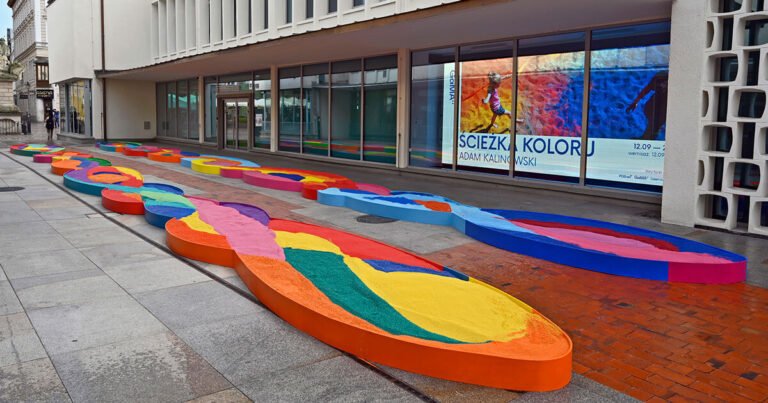
Contents
Revitalizing Public Spaces: ADAM KALINOWSKI’s COLOR PATH Installation in Poznań, Poland
ADAM KALINOWSKI’s innovative public art installation, COLOR PATH, is transforming the Pasaż Quadro in Poznań, Poland, with a vibrant and interactive display of color, texture, and movement. On view from September 12th to October 26th, 2025, this temporary installation is a must-see event that explores the relationship between material, body, and shared environment, encouraging visitors to engage with the art and each other in a unique and immersive experience.
The city of Poznań in Poland is witnessing a captivating transformation of its public space through the creative vision of artist Adam Kalinowski. His latest installation, COLOR PATH, presented at Pasaż Quadro, is an invitation to the community to immerse themselves in an evolving landscape of color and texture. Measuring 2700 x 480 x 20 cm, this interactive piece is constructed from 17 tons of colored aggregates in varying grades, set within a plywood frame. The tactile surface of the installation beckons visitors to walk across it, ideally barefoot, to experience the full sensory engagement it offers. By doing so, participants become an integral part of the artwork, reshaping its surface with each step and creating shifting patterns of color and texture.
Exploring the Concept of COLOR PATH
At its core, COLOR PATH is an investigation into how public spaces can be reimagined and transformed through the elements of color, motion, and collective presence. It challenges traditional notions of public art by incorporating the audience as active participants rather than passive observers. The installation’s design encourages movement and interaction, which in turn, continually reshapes its surface. This dynamic process highlights the symbiotic relationship between the material qualities of the artwork, the actions of its participants, and the shared environment in which it is situated.
One of the key aspects of COLOR PATH is its ability to blur the lines between the physical material of the installation, the human body, and the public space it occupies. By inviting visitors to engage directly with the artwork, Adam Kalinowski’s project underscores the importance of sensory experience and collective interaction in shaping our understanding and appreciation of public art. The use of colored aggregates and the plywood frame serves not only as a visually striking composition but also as a medium for tactile exploration, further enriching the sensory experience.
Key highlights of the COLOR PATH installation include:
- Interactive Engagement: The installation is designed for direct interaction, encouraging visitors to walk across it and reshape its surface.
- Evolving Landscape: The continuous movement across the piece creates an evolving landscape of color and texture.
- Community Participation: The project emphasizes the role of community and collective presence in transforming public spaces.
- Sensory Experience: The tactile surface invites visitors to engage their senses, particularly through touch and sight.
As Adam Kalinowski notes, the essence of COLOR PATH lies in its ability to transform and be transformed by those who interact with it. "The installation becomes a dynamic entity that reflects the collective actions and presences of those who engage with it," he explains. This perspective underscores the innovative approach the artist has taken in crafting an experience that is as much about the participants as it is about the artwork itself.
Impact and Significance
The impact of COLOR PATH extends beyond the visual and tactile experiences it offers. It also serves as a catalyst for community engagement and a platform for exploring the potential of public spaces. By temporarily disrupting the routine use of Pasaż Quadro, the installation invites reflection on how public areas can be repurposed and reimagined for creative and communal activities. This temporary transformation of a public space into an interactive art piece signifies a broader movement towards more inclusive, dynamic, and community-driven urban environments.
Future of Public Art Installations
Projects like COLOR PATH pave the way for future public art installations that prioritize interaction, sensory experience, and community engagement. They demonstrate the potential for art to become a central element in the revitalization and reimagination of urban spaces, fostering a sense of community and encouraging the public to view their environment in a new and dynamic way.
In conclusion, ADAM KALINOWSKI’s COLOR PATH installation at Pasaż Quadro in Poznań, Poland, is a pioneering example of how public art can transform and be transformed by the community. Through its innovative use of material, emphasis on collective interaction, and sensory engagement, this temporary installation offers a glimpse into the future of public art and its potential to revitalize urban spaces.
Keywords: ADAM KALINOWSKI, COLOR PATH, public art installation, interactive art, collective presence, public space transformation, community engagement, sensory experience, urban revitalization, dynamic landscapes, tactile surfaces, plywood frame, colored aggregates.
Hashtags: #PublicArt #InteractiveInstallation #CommunityEngagement #UrbanRevitalization #SensoryExperience #ADAMKALINOWSKI #COLORPATH #PoznańPoland #PolandArt #ArtInstallation #CollectivePresence #DynamicLandscapes #TactileSurfaces #ColoredAggregates #PlywoodFrame #UrbanSpaces #Revitalization #InnovativeArt #CommunityDriven #InclusiveEnvironments #FutureOfPublicArt #ArtAndCommunity #PublicSpaceTransformation.